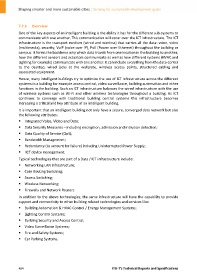Page 494 - Shaping smarter and more sustainable cities - Striving for sustainable development goals
P. 494
7.2.1 Overview
One of the key aspects of an intelligent building is the ability it has for the different sub‐systems to
communicate with one another. This communication will occur over the ICT infrastructure. The ICT
infrastructure is the transport medium (wired and wireless) that carries all the data: voice, video
(multimedia), security, VoIP (voice over IP), PoE (Power over Ethernet) throughout the building or
campus. It forms the backbone why which data travels from one location in the building to another,
how the different sensors and actuators communicate as well as how different systems (HVAC and
Lighting for example) communicate with one another. It can include everything from the data‐center
to the desktop, wired jacks at the wallplate, wireless access points, structured cabling and
associated equipment.
Hence, many intelligent buildings try to optimize the use of ICT infrastructure across the different
systems in a building for example access control, video surveillance, building automation and other
functions in the building. Such an ICT infrastructure balances the wired infrastructure with the use
of wireless systems such as Wi‐Fi and other wireless technologies throughout a building. As ICT
continues to converge with traditional building control systems this infrastructure becomes
increasing a critical and key attribute of an intelligent building.
It is important that an intelligent building not only have a secure, converged data network but also
the following attributes:
Integrated Voice, Video and Data;
Data Security Measures – including encryption, admission and intrusion detection;
Data Quality of Service (QoS);
Bandwidth Management;
Redundancy (to account for failure) including Uninterrupted Power Supply;
ICT device management.
Typical technologies that are part of a Data / ICT infrastructure include:
Networking LAN infrastructure;
Core Routing Switching;
Access Switching;
Wireless Networking;
Firewalls and Network Routers.
In addition to the above technologies, the same infrastructure will have the capability to provide
support and connectivity to other building related technologies and services like:
Building Automation & HVAC Control / Energy Management Systems;
Lighting Control Systems;
Building Security and Access Control;
Video Surveillance Systems;
Fire and Safety Systems;
Car Parking Systems.
484 ITU‐T's Technical Reports and Specifications

